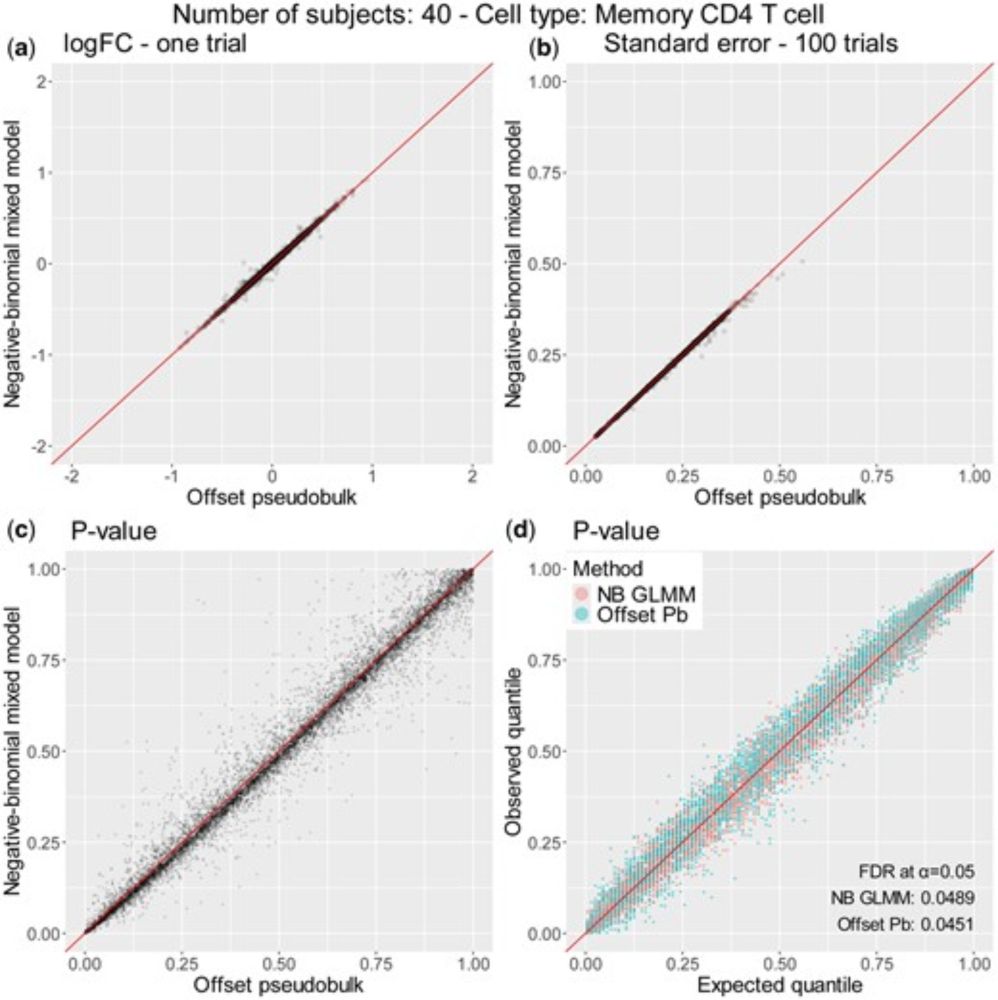I wrote about AI foundation models for biology last year: www.nytimes.com/2024/03/10/s... Benchmarking tests since then aren't finding that they're better than simpler models of how genes and cells work.
04.08.2025 16:45 — 👍 27 🔁 13 💬 0 📌 0
Haha, would also be a succinct summary of most of my academic work 😅
04.08.2025 15:38 — 👍 2 🔁 0 💬 1 📌 0
- Li et al. doi.org/10.1101/2024.12.23.630036
- Chen Li et al. doi.org/10.1101/2024.12.20.629581
- Wong et al. doi.org/10.1093/bioinformatics/btaf317
And probably many more that I am missing here.
04.08.2025 13:52 — 👍 8 🔁 0 💬 1 📌 0
- @kasparmartens.bsky.social et al. openreview.net/forum?id=eb3ndUlkt4
- Gaudelet et al. doi.org/10.48550/arXiv.2404.16907
- @aaronwtr.bsky.social et al. openreview.net/forum?id=t04D9bkKUq
- Bendidi et al. doi.org/10.48550/arXiv.2410.13956
- Wu et al. doi.org/10.48550/arXiv.2408.10609
04.08.2025 13:52 — 👍 8 🔁 0 💬 1 📌 0
I also encourage everyone to checkout the parallel efforts by groups around the world who came to similar conclusions:
- @ekernf01.bsky.social et al. doi.org/10.1101/2023.07.28.551039
- Csendes et al. doi.org/10.1186/s12864-025-11600-2
- @kasia.codes et al. doi.org/10.1186/s13059-025-03574-x
04.08.2025 13:52 — 👍 11 🔁 0 💬 1 📌 0
A recap of virtual cell releases circa June 2025
In October 2024, I twote that “something is deeply wrong” with what we now call virtual cell models. A lot has happened since then: modelers are advancing new architectures and mining new sources of i...
*We benchmarked scGPT, scFoundation, GEARS, CPA (which claim predictive ability), and scBERT, Geneformer, and UCE (which do not claim this ability). I can't comment on methods released in the last 5 months. For a summary of recent developments, see @ekernf01.bsky.social's post
04.08.2025 13:52 — 👍 7 🔁 0 💬 1 📌 0
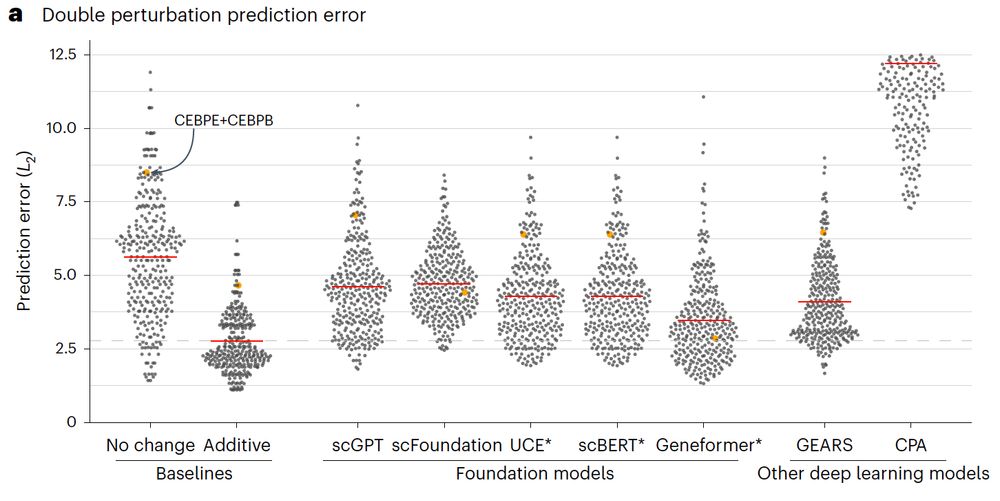
Beeswarm plot of the prediction error across different methods of double perturbations showing that all methods (scGPT, scFoundation, UCE, scBERT, Geneformer, GEARS, and CPA) perform worse than the additive baseline.
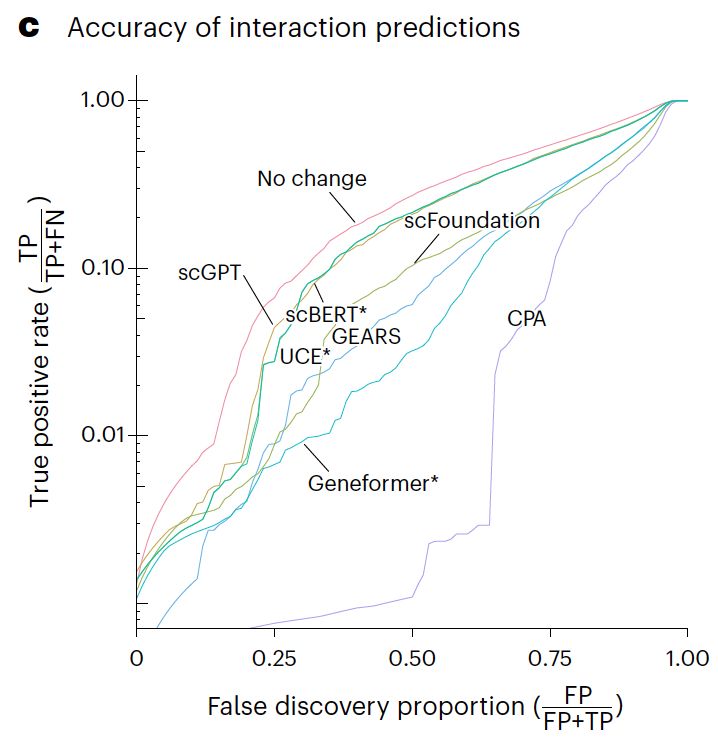
Line plot of the true positive rate against the false discovery proportion showing that none of the methods is better at finding non additive interactions than simply predicting no change.
Our paper benchmarking foundation models for perturbation effect prediction is finally published 🎉🥳🎉
www.nature.com/articles/s41...
We show that none of the available* models outperform simple linear baselines. Since the original preprint, we added more methods, metrics, and prettier figures!
🧵
04.08.2025 13:52 — 👍 85 🔁 36 💬 2 📌 6
That's amazing. Congratulations 🎉
03.07.2025 08:23 — 👍 1 🔁 0 💬 1 📌 0
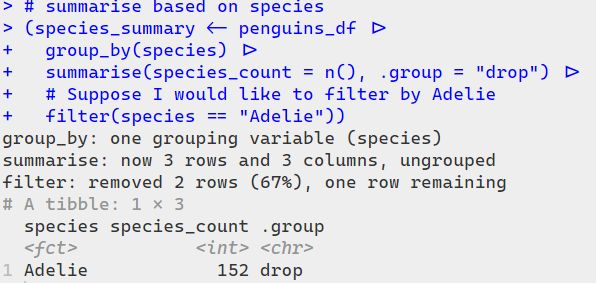
With {tidylog}, you see friendly messages like:
summarise: now 3 rows and 3 columns, ungrouped
filter: removed 2 rows (67%), one row remaining
With {tidylog}, you see friendly messages like:
summarise: now 3 rows and 3 columns, ungrouped
filter: removed 2 rows (67%), one row remaining
✨ It’s like having a gentle co-pilot, helping you track what each step is doing — super useful for debugging and learning!
08.05.2025 13:28 — 👍 23 🔁 8 💬 2 📌 0
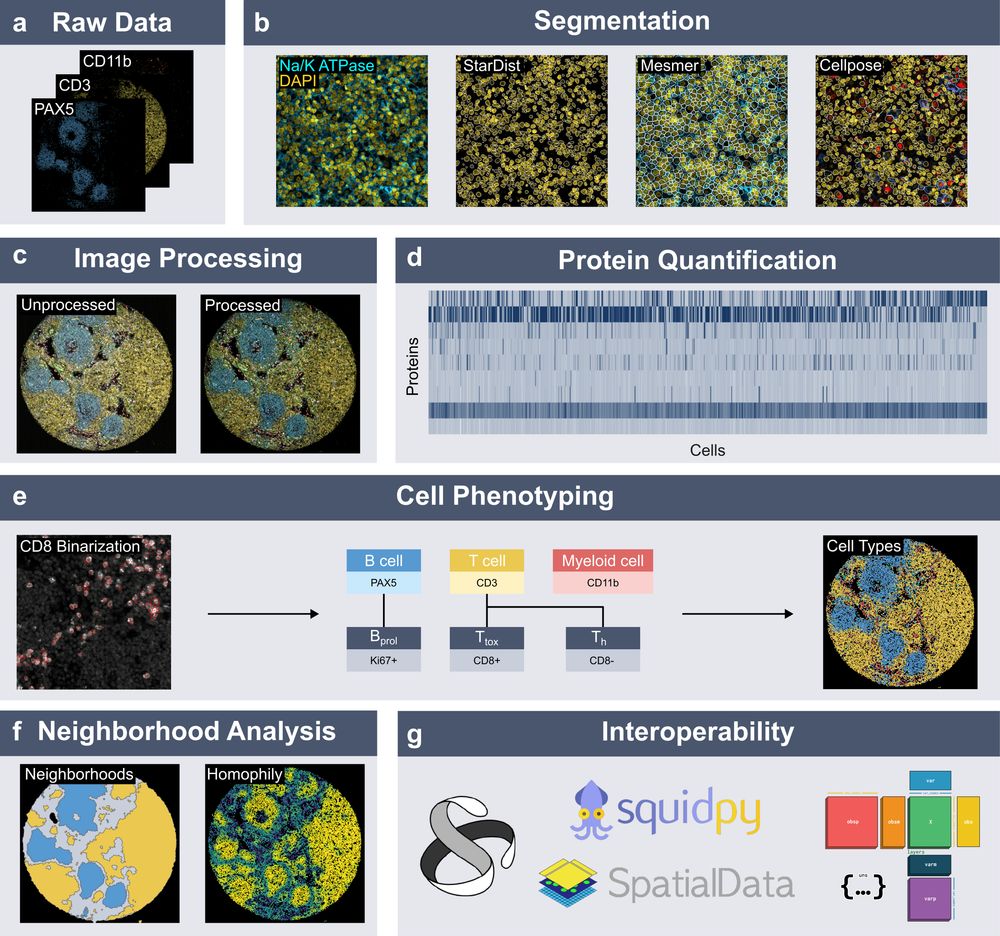
Spatialproteomics orchestrates workflows to analyze highly multiplexed images. It segments cells, processes images, quantifies proteins, predicts cell types, and provides neighborhood analysis methods, all while integrating into the scverse ecosystem.
New preprint out!
We introduce 𝐬𝐩𝐚𝐭𝐢𝐚𝐥𝐩𝐫𝐨𝐭𝐞𝐨𝐦𝐢𝐜𝐬, a Python package for end-to-end processing and analysis of highly multiplexed immunofluorescence imaging data.
Built on xarray and dask, with seamless integration into the scverse ecosystem.
www.biorxiv.org/content/10.1...
05.05.2025 11:30 — 👍 11 🔁 1 💬 1 📌 0
(2/3)
Constantin Ahlmann-Eltze showcased impressive work on assembling an atlas of T cells in precancerous samples. They developed the R packages treelabel and Shinytreelabel, which showed GITR+ Tregs are enriched in several precancerous samples, suggesting avenues for future treatments
10.04.2025 11:43 — 👍 2 🔁 1 💬 0 📌 0
A friend of mine recommends the Bahnstadt Edeka Fleischtheke. (Vegetarian myself, so no first-hand experience 😅)
21.03.2025 07:29 — 👍 1 🔁 0 💬 1 📌 0
Open positions - AG Imkeller
We are recruiting a PhD student in Computational Biology to work on omics data and spatial integration in cellular immunotherapy of cancer. Joint project with the group of Florian Büttner. @loewe-fci.bsky.social
agimkeller.github.io/recruit.html
11.03.2025 08:59 — 👍 4 🔁 6 💬 0 📌 1

LEMUR simplified | const-ae
A simplified implementation of the LEMUR algorithm.
Blog post by @const-ae.bsky.social with a simple explanation of the manifold regression algorithm & code that underlies our paper “Analysis of multi-condition single-cell data with latent embedding multivariate regression” (doi.org/10.1002/eji....).
const-ae.name/post/2025-01...
04.03.2025 18:27 — 👍 26 🔁 5 💬 1 📌 0

Abstract submissions are now open for the European Bioconductor Conference (EuroBioC2025), 17-19 September 2025 in Barcelona.
This event will bring together the Bioconductor community in Europe to advance bioinformatics, data science, and open-source software.
eurobioc2025.bioconductor.org
28.02.2025 15:07 — 👍 9 🔁 6 💬 0 📌 0
![wrap_in_tibble <- function(...){
dots <- rlang::enquos(...)
# Let's assume I can be sure that the environment is the same across dots
eval_in_mtcars(tibble::tibble(!!! dots), env = rlang::quo_get_env(dots[[1]]))
}
eval_in_mtcars <- function(expr, env){
quo <- rlang::enquo(expr)
quo <- rlang::new_quosure(rlang::quo_squash(quo), env)
rlang::eval_tidy(quo, data = mtcars[1:3,])
}
wrap_in_tibble(mpg * 3)
#> # A tibble: 3 × 1
#> `mpg * 3`
#> <dbl>
#> 1 63
#> 2 63
#> 3 68.4](https://cdn.bsky.app/img/feed_thumbnail/plain/did:plc:pa4xdweapw6gnh42xqptt6vb/bafkreiedsb67npdkhwoxx3u5ceu5rfpbktvwe5dbuwqxpuledeqb43fhyu@jpeg)
wrap_in_tibble <- function(...){
dots <- rlang::enquos(...)
# Let's assume I can be sure that the environment is the same across dots
eval_in_mtcars(tibble::tibble(!!! dots), env = rlang::quo_get_env(dots[[1]]))
}
eval_in_mtcars <- function(expr, env){
quo <- rlang::enquo(expr)
quo <- rlang::new_quosure(rlang::quo_squash(quo), env)
rlang::eval_tidy(quo, data = mtcars[1:3,])
}
wrap_in_tibble(mpg * 3)
#> # A tibble: 3 × 1
#> `mpg * 3`
#> <dbl>
#> 1 63
#> 2 63
#> 3 68.4
I have found a solution that works by squashing the quasi-quotation and explicitly setting the environment.
I still wonder if there is a better solution or if someone (maybe @lionelhenry.bsky.social? 😅) would have to write a `quo_squash` function that retains the environments. :)
#Rstats
19.02.2025 15:57 — 👍 1 🔁 0 💬 0 📌 0
You are right; that would work here. I am still a bit uneasy because, even after re-reading the evaluation chapter in Advanced R, I feel like I don't understand the bigger picture.
19.02.2025 14:11 — 👍 2 🔁 0 💬 1 📌 0
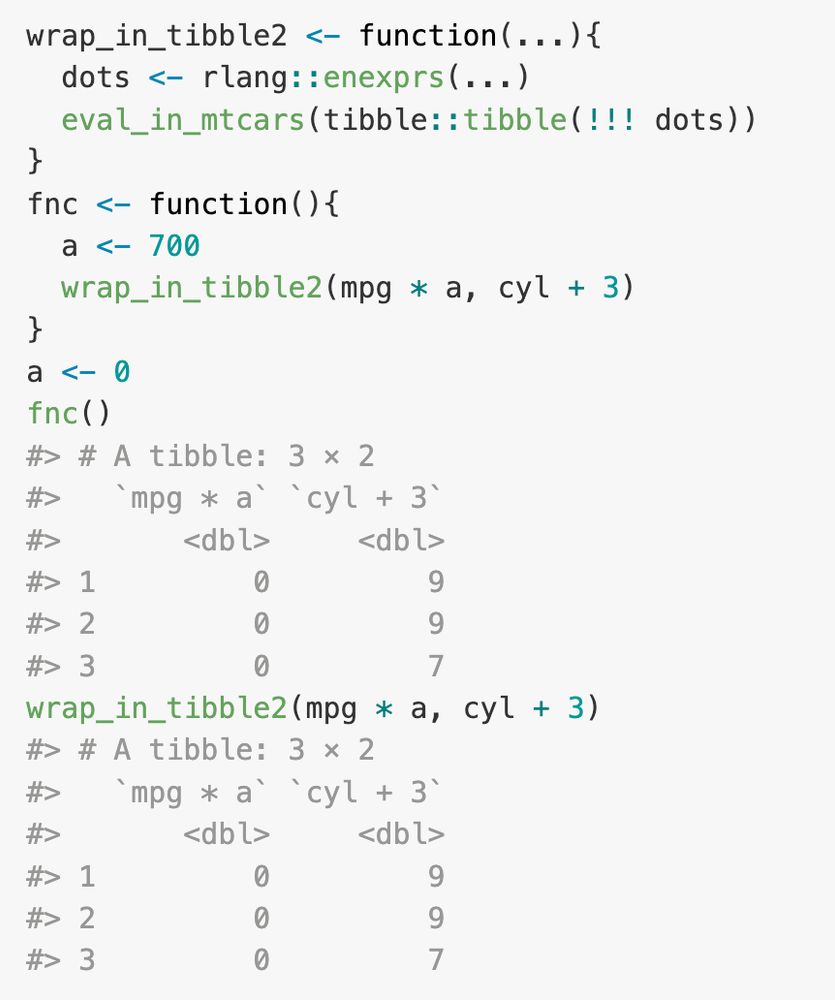
wrap_in_tibble2 <- function(...){
dots <- rlang::enexprs(...)
eval_in_mtcars(tibble::tibble(!!! dots))
}
fnc <- function(){
a <- 700
wrap_in_tibble2(mpg * a, cyl + 3)
}
a <- 0
fnc()
wrap_in_tibble2(mpg * a, cyl + 3)
In this example `enexprs()` would work, but it breaks if I call `wrap_in_tibble` from a function. (When calling fnc(), it should evaluate the quasi-quotation with a=700.)
19.02.2025 09:41 — 👍 1 🔁 0 💬 1 📌 0
![wrap_in_df <- function(...){
dots <- rlang::enquos(...)
eval_in_mtcars(data.frame(!!! dots))
}
wrap_in_tibble <- function(...){
dots <- rlang::enquos(...)
eval_in_mtcars(tibble::tibble(!!! dots))
}
eval_in_mtcars <- function(expr){
quo <- rlang::enquo(expr)
rlang::eval_tidy(quo, data = mtcars[1:3,])
}
wrap_in_df(mpg * 2, cyl + 3)
#> X.mpg...2 X.cyl...3
#> 1 42.0 9
#> 2 42.0 9
#> 3 45.6 7
wrap_in_tibble(mpg * 2, cyl + 3)
#> Error: object 'mpg' not found](https://cdn.bsky.app/img/feed_thumbnail/plain/did:plc:pa4xdweapw6gnh42xqptt6vb/bafkreihxqsxhceomx7l4lv6g5zk5ocw4vy7mlpyxf7fg5qssa5gnvjbe4q@jpeg)
wrap_in_df <- function(...){
dots <- rlang::enquos(...)
eval_in_mtcars(data.frame(!!! dots))
}
wrap_in_tibble <- function(...){
dots <- rlang::enquos(...)
eval_in_mtcars(tibble::tibble(!!! dots))
}
eval_in_mtcars <- function(expr){
quo <- rlang::enquo(expr)
rlang::eval_tidy(quo, data = mtcars[1:3,])
}
wrap_in_df(mpg * 2, cyl + 3)
#> X.mpg...2 X.cyl...3
#> 1 42.0 9
#> 2 42.0 9
#> 3 45.6 7
wrap_in_tibble(mpg * 2, cyl + 3)
#> Error: object 'mpg' not found
Is there some clever syntax to control when a quasi-quotation is evaluated so that the wrap_in_tibble function works? 🧐
(Context in stackoverflow.com/questions/79...)
#Rstats #rlang
19.02.2025 09:17 — 👍 2 🔁 2 💬 3 📌 0
Thrilled to share that our work from Trumpp Lab @hi-stem @dkfz.bsky.social is out in Nature.
We provide the first single-cell data on neurons infiltrating pancreatic tumors, offering new insights into cancer therapy. #cancerneuroscience @cn-hd.bsky.social
www.nature.com/articles/s41...
18.02.2025 09:37 — 👍 49 🔁 20 💬 2 📌 3
Thanks. It's actually build on top of plotgardener, so thanks for that one :)
12.02.2025 11:55 — 👍 1 🔁 0 💬 1 📌 0
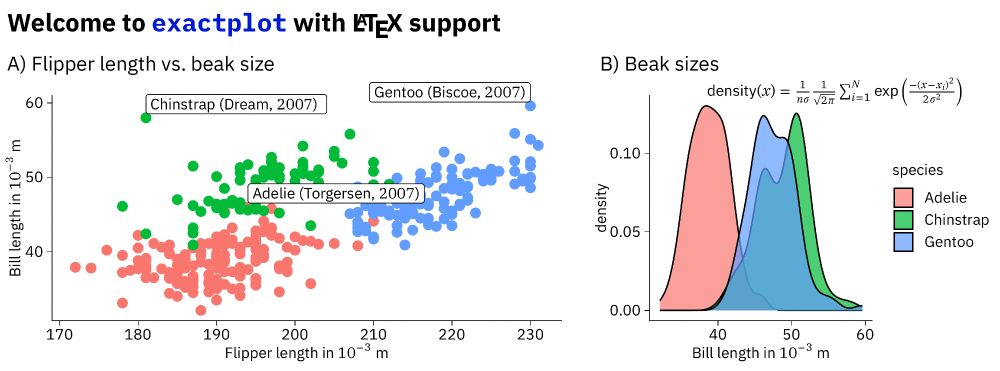
Plot produced with exactplot
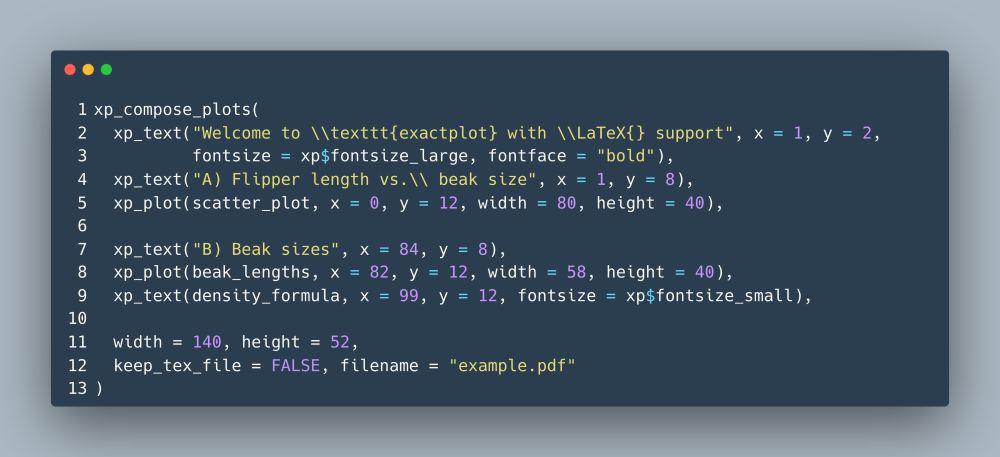
xp_compose_plots(
xp_text("Welcome to \\texttt{exactplot} with \\LaTeX{} support", x = 1, y = 2,
fontsize = xp$fontsize_large, fontface = "bold"),
xp_text("A) Flipper length vs.\\ beak size", x = 1, y = 8),
xp_plot(scatter_plot, x = 0, y = 12, width = 80, height = 40),
xp_text("B) Beak sizes", x = 84, y = 8),
xp_plot(beak_lengths, x = 82, y = 12, width = 58, height = 40),
xp_text(density_formula, x = 99, y = 12, fontsize = xp$fontsize_small),
width = 140, height = 52,
keep_tex_file = FALSE, filename = "example.pdf"
)
I just uploaded the first version of {{exactplot}} to github.com/const-ae/exa... 🎉
It produces figures with consistent font size, Latex labels, and millimeter-perfect layouting. It's an alternative to patchwork with less elegant syntax but much more flexibility.
#rstats
12.02.2025 11:40 — 👍 103 🔁 24 💬 6 📌 0

Plot produced with exactplot that contains Latex labels and has embedded fonts.
I compiled my workflow for producing pretty figures into a small package: github.com/const-ae/exa...
My trick is to use `tikzDevice` and do all the rendering with Luatex. I can position every panel and label with millimeter precision and still modify the output with Illustrator.
12.02.2025 11:27 — 👍 1 🔁 0 💬 0 📌 0
We have additional available spots. Please consider joining! It will be a blast.
30.01.2025 16:24 — 👍 2 🔁 2 💬 0 📌 0
Developing data intensive computational methods • PI @ Seoul National University 🇰🇷 • #FirstGen • he/him • Hauptschüler
NYT columnist. Signal: carlzimmer.31
Newsletter: https://buttondown.com/carlzimmer/
Web: http://carlzimmer.com
[This account includes a tweet archive]
Genomics biologist. Group leader at MRC Laboratory of Medical Sciences, Hon. Senior Lecturer (Associate Prof.) at Imperial College London.
Opinions / view my own.
https://functionalgenecontrol.group
PostDoc with @jshendure.bsky.social
Phylogenetics | Statistical Inference | Single-cell
Research Scientist; AI + Biology
thomas-a-neil.github.io
Complex traits, gene regulation, ethics & law
PhD candidate with the Pritchard Lab @Stanford
Amateur neuroscientist, quite a bit of experience in single cell analysis, working on #neurodegeneration @ Roche in Basel. Formerly postdoc with @markrobinsonca.bsky.social at UZH.
PhD student in Computational Biology @MPIBiochemistry/@MannLabs | Excited about Spatial Proteomics, Open Software + Collaborative Science
Assistant professor, WashU Pathology & Immunology
Author of FGSEA and other packages for omics data analysis
https://scholar.google.com/citations?user=fcH0gPgAAAAJ
https://github.com/assaron
Started with lasers and nonlinear optics, now with biomedical informatics, data and statistics in health sciences.
Research in #Metaresearch, #rheumatology and #publichealth at HUG and University of Geneva.
#Rstats ninja, #Openscience
Computer Science PhD Student at @humboldtuni.bsky.social and @mdc-berlin.bsky.social | Data Science | Machine learning | AI | Bioinformatics | Genomics | Single-Cell Biology
AI Research Scientist @alleninstitute.org | PhD from @ox.ac.uk | prev: intern @msftresearch.bsky.social New England & Novo Nordisk | she/her | kasia.codes
PhD student @EMBL Heidelberg in the Petridou Group
🔬🐟⚙️ ✨Morphogenesis, developmental biology, collectives
... all while loving outdoor action 🚵🏽♀️🍃🧗🏽♀️
*The necessity and power of random, under-sampled experiments in biology...
*🍫-🐭, PERTURB-CAST, RUBIX...
Assistant Investigator at the Gladstone-UCSF Institute of Genomic Immunology
Computational Cancer Genomics Group
LOGML (London Geometry and Machine Learning) aims to bring together mathematicians and computer scientists to collaborate on a variety of problems at the intersection of geometry and machine learning.
Schapiro lab at Heidelberg University and Heidelberg University Hospital. We work on #HighlyMultiplexedImaging and #SpatialOmics
Cartoonist for New Yorker
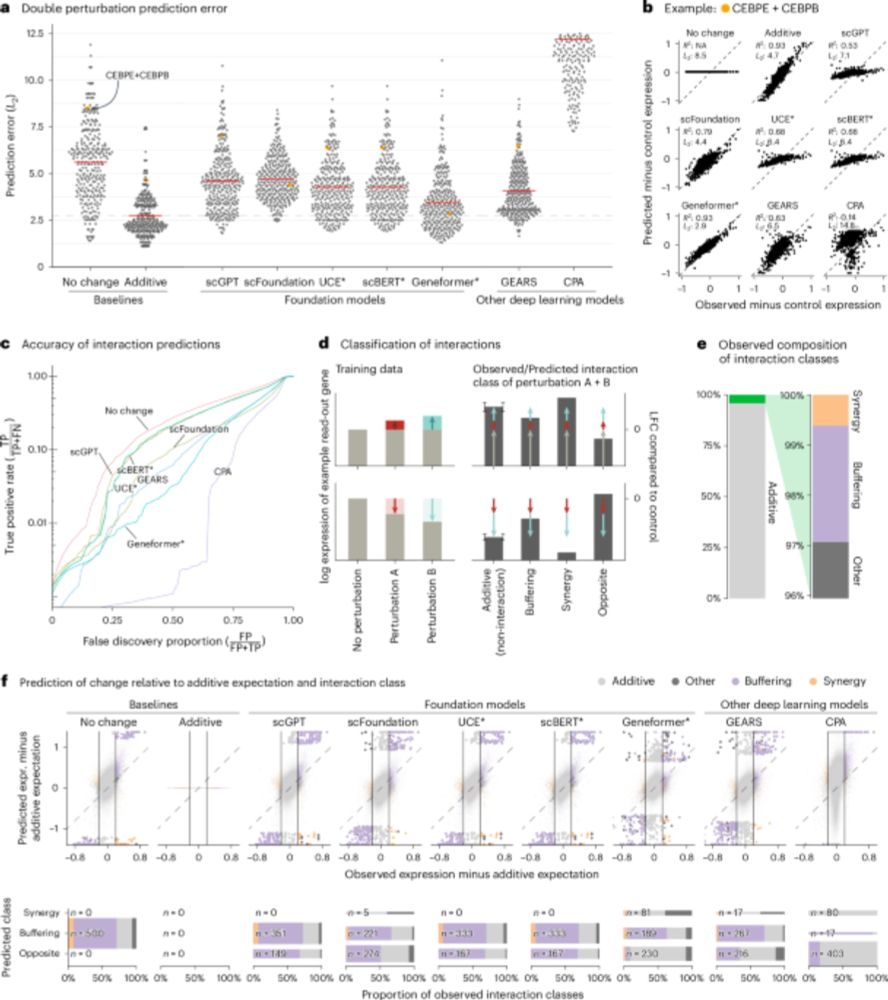
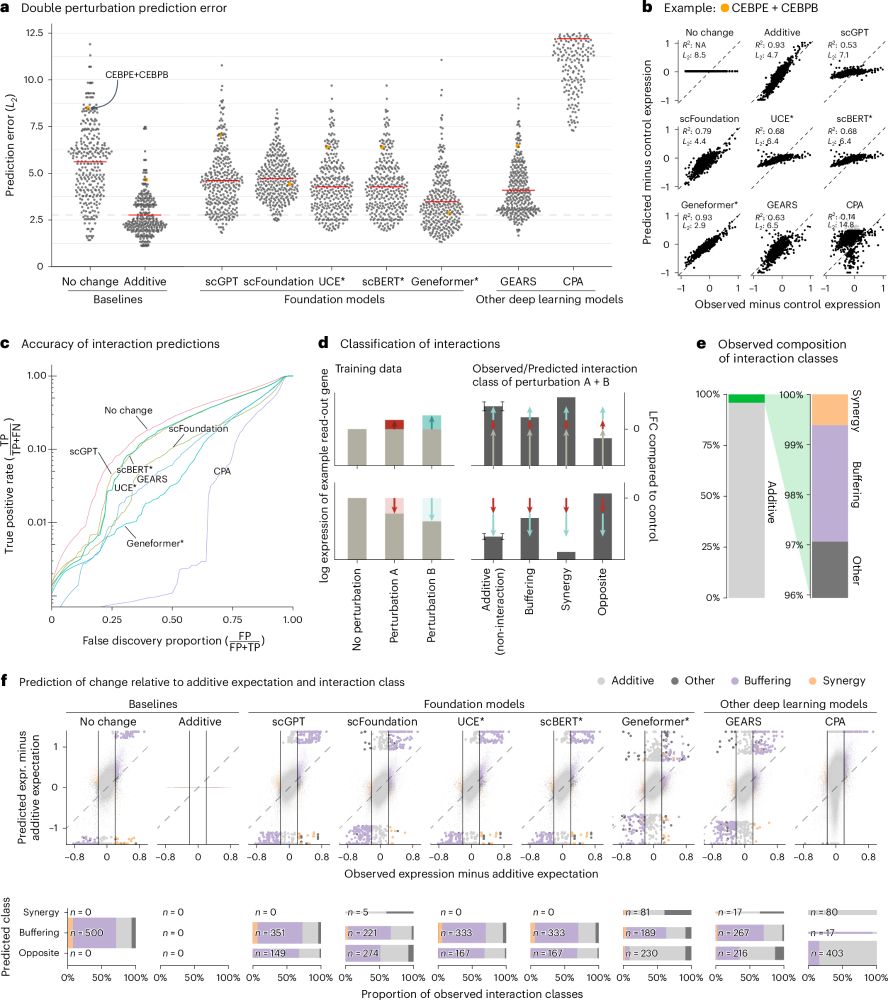





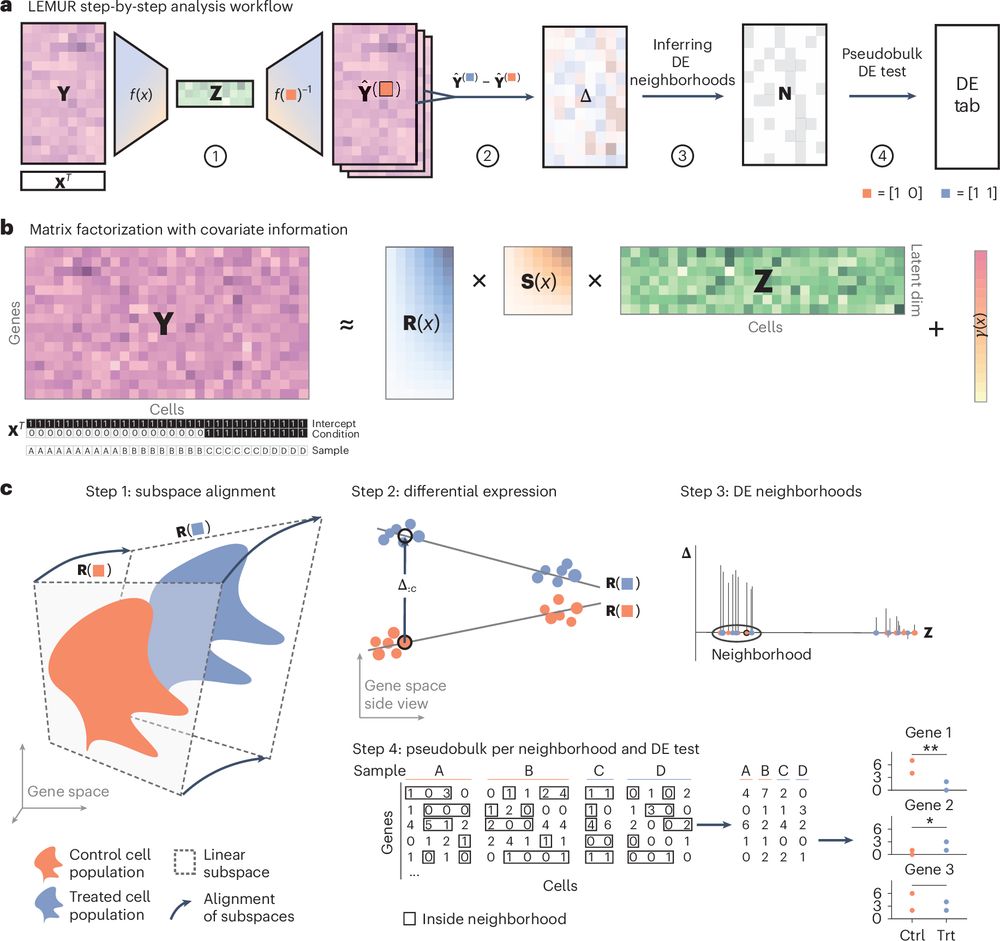


![wrap_in_tibble <- function(...){
dots <- rlang::enquos(...)
# Let's assume I can be sure that the environment is the same across dots
eval_in_mtcars(tibble::tibble(!!! dots), env = rlang::quo_get_env(dots[[1]]))
}
eval_in_mtcars <- function(expr, env){
quo <- rlang::enquo(expr)
quo <- rlang::new_quosure(rlang::quo_squash(quo), env)
rlang::eval_tidy(quo, data = mtcars[1:3,])
}
wrap_in_tibble(mpg * 3)
#> # A tibble: 3 × 1
#> `mpg * 3`
#> <dbl>
#> 1 63
#> 2 63
#> 3 68.4](https://cdn.bsky.app/img/feed_thumbnail/plain/did:plc:pa4xdweapw6gnh42xqptt6vb/bafkreiedsb67npdkhwoxx3u5ceu5rfpbktvwe5dbuwqxpuledeqb43fhyu@jpeg)

![wrap_in_df <- function(...){
dots <- rlang::enquos(...)
eval_in_mtcars(data.frame(!!! dots))
}
wrap_in_tibble <- function(...){
dots <- rlang::enquos(...)
eval_in_mtcars(tibble::tibble(!!! dots))
}
eval_in_mtcars <- function(expr){
quo <- rlang::enquo(expr)
rlang::eval_tidy(quo, data = mtcars[1:3,])
}
wrap_in_df(mpg * 2, cyl + 3)
#> X.mpg...2 X.cyl...3
#> 1 42.0 9
#> 2 42.0 9
#> 3 45.6 7
wrap_in_tibble(mpg * 2, cyl + 3)
#> Error: object 'mpg' not found](https://cdn.bsky.app/img/feed_thumbnail/plain/did:plc:pa4xdweapw6gnh42xqptt6vb/bafkreihxqsxhceomx7l4lv6g5zk5ocw4vy7mlpyxf7fg5qssa5gnvjbe4q@jpeg)



